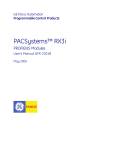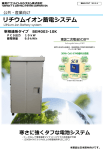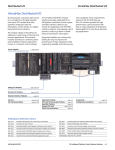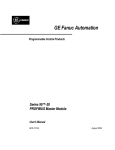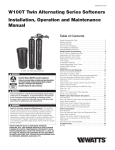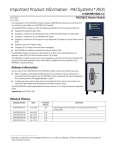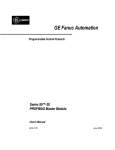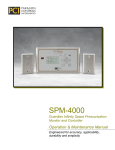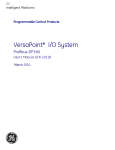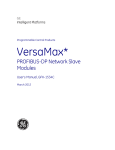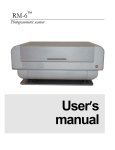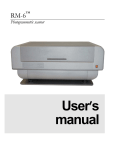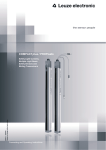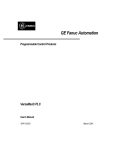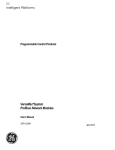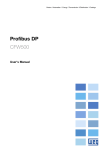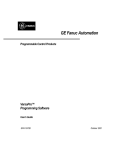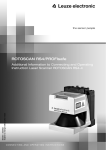Download VersaMax PROFIBUS Master Module User`s Manual
Transcript
GE Intelligent Platforms Programmable Control Products VersaMax* PROFIBUS Master Module User's Manual, GFK-2740A June 2012 GFL-002 Warnings, Cautions, and Notes as Used in this Publication Warning Warning notices are used in this publication to emphasize that hazardous voltages, currents, temperatures, or other conditions that could cause personal injury exist in this equipment or may be associated with its use. In situations where inattention could cause either personal injury or damage to equipment, a Warning notice is used. Caution Caution notices are used where equipment might be damaged if care is not taken. Note: Notes merely call attention to information that is especially significant to understanding and operating the equipment. This document is based on information available at the time of its publication. While efforts have been made to be accurate, the information contained herein does not purport to cover all details or variations in hardware or software, nor to provide for every possible contingency in connection with installation, operation, or maintenance. Features may be described herein which are not present in all hardware and software systems. GE Intelligent Platforms assumes no obligation of notice to holders of this document with respect to changes subsequently made. GE Intelligent Platforms makes no representation or warranty, expressed, implied, or statutory with respect to, and assumes no responsibility for the accuracy, completeness, sufficiency, or usefulness of the information contained herein. No warranties of merchantability or fitness for purpose shall apply. * indicates a trademark of GE Intelligent Platforms, Inc. and/or its affiliates. All other trademarks are the property of their respective owners. ©Copyright 2012 GE Intelligent Platforms, Inc. All Rights Reserved Contact Information If you purchased this product through an Authorized Channel Partner, please contact the seller directly. General Contact Information Online technical support and GlobalCare http://www.ge-ip.com/support Additional information http://www.ge-ip.com/ Solution Provider [email protected] Technical Support If you have technical problems that cannot be resolved with the information in this guide, please contact us by telephone or email, or on the web at www.ge-ip.com/support Americas Online Technical Support www.ge-ip.com/support Phone 1-800-433-2682 International Americas Direct Dial 1-780-420-2010 (if toll free 800 option is unavailable) Technical Support Email [email protected] Customer Care Email [email protected] Primary language of support English Europe, the Middle East, and Africa Online Technical Support www.ge-ip.com/support Phone +800-1-433-2682 EMEA Direct Dial +352-26-722-780 (if toll free 800 option is unavailable or if dialing from a mobile telephone) Technical Support Email [email protected] Customer Care Email [email protected] Primary languages of support English, French, German, Italian, Czech, Spanish Asia Pacific Online Technical Support www.ge-ip.com/support Phone +86-400-820-8208 +86-21-3217-4826 (India, Indonesia, and Pakistan) Technical Support Email [email protected] (China) [email protected] (Japan) [email protected] (remaining Asia customers) Customer Care Email [email protected] [email protected] (China) Contents Introduction ............................................................................................ 1-1 PROFIBUS Master Module .......................................................................... 1-2 PROFIBUS Basics ....................................................................................... 1-4 Installation .............................................................................................. 2-1 Module Installation ....................................................................................... 2-2 Connecting the Module to the PROFIBUS Network .................................... 2-5 LED Operation ............................................................................................. 2-9 Firmware Updates ........................................................................................ 2-9 PROFIBUS Master Module Configuration ........................................... 3-1 Adding the PROFIBUS Master Module to the Configuration ....................... 3-2 Configuring PROFIBUS Master Module Parameters................................... 3-3 Configuring Network Settings for PROFIBUS Master.................................. 3-7 Adding Slave Devices to the PROFIBUS Master ...................................... 3-14 Diagnostics ............................................................................................ 4-1 PROFIBUS Master Module LEDs ................................................................ 4-2 Status Arrays................................................................................................ 4-3 Fault Table Entries ....................................................................................... 4-4 Memory Mapped Communication Requests ................................................ 4-5 Device Information Details ......................................................................... 4-26 Memory Mapped COMMREQ Operation .................................................... A-1 Usage of Memory Mapped COMMREQ ...................................................... A-2 COMMREQ Programming Requirements and Recommendations ............. A-3 Error Detection and Handling....................................................................... A-4 GFK-2740A iii Introduction Chapter 1 This chapter provides an overview of the VersaMax PROFIBUS Master module, IC200BEM003. Chapter 2, Installation: Power requirements, cable specifications, grounding, and module installation. Chapter 3, PROFIBUS Master Configuration: How to configure PROFIBUS master communications. Chapter 4, PROFIBUS Master Status and Diagnostics: How to use the LED displays, Slave Status bit array, Controller fault table and memory mapped communications requests (COMMREQs) to obtain status and diagnostic information. Appendix A, COMMREQ Operation: Operation of the Communications Request function. Information about PROFIBUS The PROFIBUS logo is a registered trademark of the PROFIBUS International organization. Information about the organization and the protocol is available at http://www.profibus.com. Please refer to the following sources of PROFIBUS information: PROFIBUS standard DIN 19245 parts 1 (low-level protocol and electrical characteristics) and 3 (DP protocol) IEC 61158 ET 200 Distributed I/O system, 6ES5 998-3ES22 VersaMax Installation and Operation VersaMax PLC User’s Manual, GFK-1503 VersaMax Modules, Power Supplies, and Carriers User’s Manual, GFK-1504 VersaMax PROFIBUS-DP Network Slave Modules User’s Manual, GFK-1534 Installation Requirements for Conformance to Standards, GFK-1179 VersaMax PROFINET Scanner User’s Manual, GFK-2721 RX3i PROFINET System PACSystems RX3i PROFINET Controller Manual, GFK-2571 PACSystems CPU Reference Manual, GFK-2222 GFK-2740A 1-1 1 PROFIBUS Master Module The VersaMax PROFIBUS Master module allows a VersaMax CPU005 or CPUE05 CPU, or PROFINET Scanner module (PNS) to send and receive data on a PROFIBUS-DP network. Features The Master module provides the following PROFIBUS communications features: Supports all standard data rates Supports a maximum of 3,584 bytes of input data and 3,584 bytes of output data with a VersaMax CPU; a maximum of 1440 bytes of input data and 1440 bytes of output data with a PNS. Supports a maximum of 125 PROFIBUSDP slaves Supports a maximum of 244 bytes of input data and 244 bytes of output data for each slave Supports Sync and Freeze modes Supports DP-V1 Read, Write and Alarm messages Has PROFIBUS-compliant module and network status LEDs Firmware Upgrades The PROFIBUS module receives its firmware upgrades indirectly from the host controller CPU or PNS head end using the WinLoader software utility. WinLoader is supplied with any updates to the PROFIBUS module software. PROFIBUS Basics 1-2 VersaMax* PROFIBUS Master Module User's Manual – June 2012 GFK-2740A 1 Module Specifications PROFIBUS support PROFIBUS-DP V1 Power Consumption 450mA at +5V I/O Data With a CPU With a PNS A maximum of 3584 bytes of input data and 3584 bytes of output data A maximum of 1440 bytes of input data and 1440 bytes of output data With either CPU or PNS head end, a maximum of 244 bytes of input data and 244 bytes of output data for each slave. PROFIBUS network addresses 0 to 125, software-configurable Maximum no. of slave devices 125 Network data rate 9.6K up to 12 Mbaud (bit/sec) Status information Slave Status Bit Array Table Firmware Module Revision Slave Diagnostic Address Module isolation Network to Frame ground: 250VAC continuous, 1500VAC for 1 min Profibus network to backplane: 1500VAC minimum For product standards, general operating specifications, and installation requirements, refer to the VersaMax I/O Modules Manual, GFK-1504. GFK-2740A Chapter 1 Introduction 1-3 1 PROFIBUS Network Overview PROFIBUS is an open, vendor independent fieldbus standard for a wide range of applications in industrial automation, including motion control. PROFIBUS is a dynamic technology that grows functionally while complying with IEC 61158. PROFIBUS Guidelines and Profiles provide the means for further technical development based on the ever-changing communication requirements of the networks, systems, and devices used in today's industrial automation applications. The modules covered by this manual use the following protocols, which are defined by the PROFIBUS specification: PROFIBUS-DP: High-speed data communication. DP stands for Distributed Peripherals. In practice, the majority of slave applications are DP applications. PROFIBUS DP-V1: Contains enhancements for process automation, in particular acyclic data communication for parameter assignment, operation, visualization and interrupt control of intelligent field devices, parallel to cyclic user data communication. Note: The PROFIBUS logo is a registered trademark of the PROFIBUS International Organization. Membership in the organization is open to all individuals, companies and organizations. More information about the organization and the protocol is available at http://www.profibus.com Bus Communication The PROFIBUS specification defines the technical characteristics of a serial field bus system that links distributed digital controllers on the network, from field level to cell level. PROFIBUS is a multi-master system that allows the joint operation of several automation, engineering or visualization systems with their distributed peripherals on one bus. PROFIBUS distinguishes between the following types of devices: 1-4 Master devices determine the data communication on the bus. A master can send messages without an external request when it holds the bus access rights (the token). Masters are also called active stations. Slave devices include motion controllers, drives, I/O devices, valves, and transducers. Slaves do not have bus access rights and can only acknowledge received messages or send messages to the master when requested to do so. Slave devices are passive stations and require only small portions of the bus protocol. VersaMax* PROFIBUS Master Module User's Manual – June 2012 GFK-2740A 1 Data Bandwidth Demands on PROFIBUS Communications Systems Amount of Data Transmission Duration Transmission Frequency Management level MBytes Hours/Minutes Day/Shift Cell level KBytes Seconds Hours/Minutes Field Level Bytes Several 100 microseconds to 100 milliseconds 10 to 100 Milliseconds Actuator sensor level Bits Microseconds to milliseconds Milliseconds Network Topology PROFIBUS uses linear bus architecture with active bus termination at both ends. Devices in a PROFIBUS network connect directly to the bus cable or indirectly via stub lines. Sample PROFIBUS Network Master PROFIBUS Master Module Slaves Bus Termination Bus Termination PLC with PROFIBUS Slave Module Stub with Slaves A PROFIBUS-DP network may have up to 125 slave stations (addresses 0126 are valid addresses), however address 126 is reserved for commissioning purposes. The master must consume one of the valid addresses to create a PROFIBUS system. The bus system must be subdivided into individual segments to handle this many participants. These segments are linked by repeaters, which condition the serial signal to allow connection of segments. In practice, both regenerating and nonregenerating repeaters may be used. Regenerating repeaters condition the signal to allow increased range of the bus. Up to 32 stations are allowed per segment and the repeater counts as a station address. A specialized “link” segment consisting only of optical fiber modem repeaters may be used to span long distances. Plastic fiber optic segments are typically 50 meters or less while glass fiber; optic segments may extend several kilometers. GFK-2740A Chapter 1 Introduction 1-5 1 The user assigns a unique PROFIBUS station address to identify each master, slave, or repeater in the network. Each participant on the bus must have a unique station address. Repeaters and Bus Termination Repeater Connecting Segments Participant Participant Participant Remote Repeater Link Segment (No Participants) Termination Branch Segment Participant Participant Participant Remote Repeater Termination To additional participants Network Connectors PROFIBUS connections are typically created with a 9-pin sub-D connector. A minimum connection consists of a shielded twisted-pair cable (shield to pin 1 and twisted-pair wires to pins 3 and 8) with terminating connections in the appropriate bus plugs. The VersaMax Master and Slave modules provide a PROFIBUS standard female 9-pin D-shell subminiature connector with the following pin assignments. Note: 1-6 For information on connector pin assignments, network segment length, network connectors and network termination, and network baud rate, refer to Chapter 2, “Installation.” VersaMax* PROFIBUS Master Module User's Manual – June 2012 GFK-2740A 1 Data Consistency Data consistency ensures that a data block contains one set of updated data instead of a mixture of old and new data. In systems that provide data consistency, the master is prevented from reading or writing the slave data while the slave is updating its data area. For consistent data exchanges between any PROFIBUS master and any PROFIBUS slave, both master and slave must support consistency. All GE Intelligent Platforms PROFIBUS masters provide data consistency when used with a slave station that has data consistency. All PROFIBUS devices provide byte and word-level consistency. Some devices support whole length data consistency, meaning that all words are guaranteed to be consistent over one network scan. Whether a slave supports whole length data consistency is determined on a module-by-module basis, as specified in the GS? file associated with the slave. For each supported module type, the GS? file contains a configuration identifier that specifies module characteristics, such as data length and consistency. The following GE Intelligent Platforms slave device supports whole length data consistency for some modules: IC220PBI002 To find out whether a module supports whole length consistency, examine the configuration identifier. For explanation of the configuration identifier formats, refer to the PROFIBUS Specification. Sample Configuration Identifiers: General identifier format (identifier byte) Module = "16 byte input 8 EndModule (0x1F)" 0x1F Special identifier format Module = "16 word output 38 EndModule (0x6F)" 0x6F whether non-GE Intelligent Platforms PROFIBUS modules support consistency, refer to the documentation provided by the module manufacturer. To determine GFK-2740A Chapter 1 Introduction 1-7 Installation Chapter 2 This chapter describes: Module Installation o Module Clearance o Installing the Communications Carrier on the DIN Rail o Installing the Power Supply o Installing the Module on the Communications Carrier Connecting the Module to the PROFIBUS Network o Connector Pin Assignments o Network Segment Length o PROFIBUS Cable Types o Network Termination o Network Baud Rate LED Operation o GFK-2740A PROFIBUS Master Module Firmware Updates 2-1 2 Module Installation The PROFIBUS Master module is installed in a VersaMax PLC. Additional installation information is included in the VersaMax Modules, Power Supplies, and Carriers Manual, GFK-1504. Module Clearance Maintain a clearance of 2 inches (5.1cm) above and below the module and 1 inch (2.54cm) to the left of the PLC equipment. 133.4mm (5.25in) 66.8mm (2.63in) Installing the Communications Carrier on the DIN Rail The Profibus Master is mounted on a Communications Carrier (IC200CHS006), which is installed on the DIN rail. The Communications Carrier snaps easily onto the DIN rail. No tools are required for mounting or grounding to the rail. Note: Connecting carriers must be installed on the same section of 35mm x 7.5mm DIN rail. The DIN rail must have a conductive (unpainted) finish for proper grounding. 2-2 VersaMax* PROFIBUS Master Module User's Manual – June 2012 GFK-2740A 2 Installing the Power Supply The main power supply and any booster power supplies that are used should be installed so that they can be power-cycled at the same time. Installing the Module on the Communications Carrier Note: The BEM003 does not support hot swap (installation or removal with power applied.) 1. The latch on the module must be in the unlocked position. 2. Align the connector and the latch post and press the module down firmly, until the two tabs on the bottom of the module click into place. Be sure the tabs are fully inserted in the holes in bottom edge of the Communications Carrier. 3. Turn the latch to the locked position to secure the module to the top of the carrier. GFK-2740A Chapter 2 Installation 2-3 2 Removing the Module from the Carrier Exercise care when working around operating equipment. Devices may become very hot and could cause injury. 1. Remove power. 2. Turn the latch to the unlocked position as illustrated. 3. Disengage the tabs on the module from the holes in the carrier. 4. Pull the module straight off. 2-4 VersaMax* PROFIBUS Master Module User's Manual – June 2012 GFK-2740A 2 Connecting the Module to the PROFIBUS Network The module contains a standard female DB9 connector, labeled “PROFIBUS,” that can be connected to a PROFIBUS bus terminal that complies with EN 50170. The PROFIBUS module has no built-in termination. If termination is required, you must use a bus terminal that has built-in selectable termination. PROFIBUS DB-9 connector recommendation: Siemens 6ES7-972-OBB50-OXAO (12MB) Caution Do not connect any devices to the +5V pin (pin 6). It is to be used for termination purposes only. Doing so could damage equipment or cause erratic behavior. PROFIBUS Bus Connector Pin Assignments Pin No. Signal Designation 1 Shield Not used 2 Not used Not used 3 RxD/TxD-P Receive data / transmission data positive 4 CNTR-P Control signal for repeaters (direction control) 5 DGND Data ground 6 VP Supply voltage of the terminating resistance (+ 5V) 7 Not used Not used 8 RxD/TxD-N Receive data / transmission data negative 9 Not used Not used Network Segment Length A PROFIBUS network uses either fiber optic or RS-485 copper media. The copper bus line specified in EN 50170 is “Line Type A” and is the recommended cable type. Cable Type B should not be used with this product. It is extremely important to use cable rated to PROFIBUS specifications. The higher the baud rate selected and the longer the distances involved, the more critical cable selection becomes. (PROFIBUS cable has a distinctive purple color.) For details, see “PROFIBUS Cable Types” on page 2-6. Stub or “T” type branch connections are supported if the total stub (branch) lengths do not exceed 6.6 meters. Do not use stubs at all on 12 MBaud networks. GFK-2740A Chapter 2 Installation 2-5 2 The data rates for network communication with maximum segment trunk length for type A cable are provided in the following table. Multiple segments may be connected via repeater stations to extend the total bus length. Data Rates and Segment Lengths for Cable Type A Distance (Max) * Baud Rate Glass Fiber 9.6 Kbit/s, 19.2 Kbit/s and 93.75Kbit/s 1200 m 6 km 187.5 Kbit/s 1000 m 6 km 500 Kbit/s 400 m 6 km 1.5 MBit/s 200 m 6 km 3 MBit/s, 6 MBit/s and 12 MBit/s 100 m * Values shown are the sum of all bus segments and drop cable lengths. 6 km PROFIBUS Cable Types The recommended cable is: Belden 3079A PROFIBUS cable This is a shielded, 150 Ohms twin-axial (single twisted pair) cable. It has 0.66 mm conductor diameter and a mutual capacitance of 28 pF/m, nominal. For complete specifications on this cable, please contact your Belden dealer or visit their website at www.belden.com. Alternate cable types are: Siemens 6XV1 830-OAH10 Two Core shielded Siemens 6XV1 830-OBH10 w/PE Sheath Siemens 6XV1 830-3AH10 for underground burial Siemens 6XV1 830-3BH10 trailing cable Bosch Comnet DP #913 548 Flexible PROFIBUS cable Bosch Comnet DP #917 201 Trailing PROFIBUS Cable Bosch Comnet DP #917 202 Massive PROFIBUS Cable Notes: Allen Bradley “blue hose”, which has an impedance of 78 Ohms, is not recommended for this application. Cable type B should not be used with the PROFIBUS module. Type A Cable Specifications 2-6 Impedance 135 to 165 Ohms at f = 3 to 20 MHz Capacitance < 30 pF/m Resistance < 110 Ohms/km Core Diameter > 0.64 mm Conductor Area > 0.34 mm2 (22 AWG) VersaMax* PROFIBUS Master Module User's Manual – June 2012 GFK-2740A 2 Network Termination Termination Note: The two physical ends of the PROFIBUS network must be terminated. There should be two, and only two, terminators on a network. Termination resistors are needed, as defined in DIN 19245 Part 1 section 3.1.2.5. Master Slave Slave Slave Slave Slave Termination Required (Segment 1) One terminator must be applied at each end of a network segment. Master Slave Slave Repeater Slave Slave Slave Termination Required (Segment 2) Termination Required (Segment 1) Generally, termination is provided in commercially-available PROFIBUS standard network connectors. Some connector vendors provide termination capability in the connector and a switch on the connector to enable/disable termination. Some connector vendors provide both terminated and unterminated connectors. Note: For proper network termination, it is essential that the terminating devices maintain power. Power is provided by the device on Pin 6 and Ground on Pin 5. If power is lost to either terminating device, the network may not operate correctly. Generally, the lone network master device is one of the terminating devices. Therefore, a loss of power to the network master renders the network inoperable anyway. The other terminating device may be a critical slave device that must maintain power or a separately powered, stand-alone terminator. These stand-alone devices are commercially available. VP (6) Ru = 390 Ohms RxD/TxD-P (3) Rt = 220 Ohms RxD/TxD-N (8) Rd = 390 Ohms DGND (5) GFK-2740A Chapter 2 Installation 2-7 2 Bus Termination for Type A Cable in Accordance to PROFIBUS Specifications In addition to the termination shown on page 2-7, the following compensation should be added for 12 Mbit/s bus technology. 12 Mbit/s Bus Compensation To/from another node 110nH 9 8 7 110nH 6 5 4 110nH 3 2 1 To/from another node 110nH Network Baud Rate The master configures the appropriate network baud rate for each station on the network. Typical baud rate values are: 9.6 Kbit/s, 19.2 Kbit/s, 93.75 Kbit/s, 187.5 Kbit/s, 500 Kbit/s, 1.5 Mbit/s, 3 Mbit/s, 6 Mbit/s, or 12 Mbit/s. For details on using the configuration software, refer to chapter 3. 2-8 VersaMax* PROFIBUS Master Module User's Manual – June 2012 GFK-2740A 2 LED Operation When power is applied to the module, you can verify proper module status and communications status by checking the module LEDs. PROFIBUS Master Module LEDs – Initial Powerup On initial powerup with no configuration stored, the LED display should be as follows. For complete details on the Master module’s LED operation, refer to chapter 4. LED Color State OK Green Solid On COM Off NA STAT Green Blinking 3 times fast at 5 Hz, 8 times at 0.5 – 1 Hz Firmware Updates The PROFIBUS Master module receives firmware updates through its associated VersaMax CPU or PNS head end module. GFK-2740A Chapter 2 Installation 2-9 Chapter 3 PROFIBUS Master Module Configuration These configuration procedures are written for users with at least a basic knowledge of the Machine Edition Logic Developer software and the VersaMax PLC. For help with using the software, please see the software’s built-in help system. Note: The PROFIBUS Master module does not support redundant masters. Software configuration of the PROFIBUS Master module consists of the following steps: GFK-2740A Adding the PROFIBUS master module to the configuration, page 3-2 Configuring the PROFIBUS Master parameters, page 3-3 Configuring network settings for the PROFIBUS Master, page 3-8 Adding slave devices to the PROFIBUS master configuration, page 3-15 3-1 3 Adding the PROFIBUS Master Module to the Configuration Adding the IC200BEM003 Module to a VersaMax Rack Configuration The Master module can be placed in any module location in the system. 1. Configure a VersaMax Communications carrier in the desired slot location. 2. Configure an IC200BEM003 PROFIBUS Master module on the Communications carrier, IC200CHS006. 3. To configure the Master module’s parameters, right click the IC200BEM003 and choose Configure. Adding the IC200BEM003 Module to an RX3i PROFINET Network The Master module can be configured as a module on a VersaMax PROFINET Scanner (PNS) in an RX3i PROFINET network. The BEM003 requires a PNS version 1.10 or later. 4. Configure an RX3i PROFINET System with a PROFINET Scanner. For details, refer to the PACSystems RX3i PROFINET Controller Manual, GFK-2571 5. Add an IC200BEM003 module to the PNS remote node. (Right click the PNS to open the Change Module List, expand Bus Controller and drag the IC200BEM003 into the modules list.) 6. Close the Change Module List window and return to the tree view. 7. To configure the Master module’s parameters, right click the IC200BEM003 and choose Configure. 3-2 VersaMax* PROFIBUS Master Module User's Manual – June 2012 GFK-2740A 3 Configuring PROFIBUS Master Module Parameters The parameters on the Settings tab are used to configure the operation of the PROFIBUS master. Settings Tab Slave Status Bit Array Address The starting address for the consumed range used to receive the status bits from slaves that are configured and exchanging I/O with the BEM003. This array of bits indicates the health of each node on the PROFIBUS network. The Slave Status Bit Array must be a non-overlapping range in %I, %Q, %T, or %M. Defaults to %I memory. A slave's status address equals Start Address + Station Address of the slave. For example, if the status bits are mapped to %I00001, the status for the slave at Station Address 5 would be found at %I00006. The master’s status is located in the same way as the slaves’ (Start Address + Station Address). The master is configured as station 0 by default, but can be set to any valid address (0125). For information on changing the master’s station address, see “Configuring Network Settings for PROFIBUS Master” on page 3-8. Tip: ■ Use the Communication Request (COMMREQ) command 1 (Get Device Status) or command 2 (Get Master Status) to retrieve the status information that is reported in this memory area. For details, see “Communication Requests” in chapter 4. Length Slave Diagnostics ID Address Length GFK-2740A Fixed length is 128 bits. The starting address for this 32 bit (two-word) consumed array. The Slave Diagnostics ID array requires a nonoverlapping range in %AI, %AQ or %R. Defaults to %AI memory. The first word (Slave Diagnostics) is used by the PROFIBUS master to communicate the station address of any slave that has reported diagnostic data. If diagnostics are pending, the master places the address of the first slave that has diagnostics into this word. The diagnostics can be read using the Get Device Diagnostics COMMREQ (command 4). This clears the word and the master then places the next pending diagnostic address into the Slave Diagnostics word. If the word is zero there are no pending diagnostics. The second word is set to a value of 0. Fixed length is 2 words. Chapter 3 PROFIBUS Master Module Configuration 3-3 3 3-4 Sync/Freeze Control Bits Address The starting reference address of a 16-bit (1-word) produced range used for the Sync/Freeze command data. The Sync/Freeze Control Bits must be in a non-overlapping range in %I, %Q, %T, or %M. Defaults to %Q memory. Sync and Freeze are global control functions used to synchronize remote I/O stations. You can use these functions to cause a group of slaves to operate at the same time in your system. For additional information, see “Using Sync/Freeze Control” on page 3-7. Length Fixed length is 16 bits. DPV1 Status The starting reference address of a 32-bit (2-word) produced range used at the beginning of a scan to receive the station address of a slave that has sent a DPV1 Alarm message. If another slave has sent a DPV1 alarm message, it is ignored until the first one has been serviced, and will then appear in a subsequent scan. To acknowledge the DPV1 Alarm message and obtain the alarm information it contains, use a DPV1 Alarm Acknowledge (command 9) COMMREQ. The DPV1 Acknowledge block must be a non overlapping range in %AI, %AQ or %R. Defaults to %AI memory. For the block format, see “DPV1 Alarm Acknowledge” in chapter 4. Length Fixed length is 2 words (32 bits). Slave Configured Bits The starting address for the consumed range used to receive the array of bits that indicate which slaves on the PROFIBUS network are configured. The array contains 128 bits (8 words). The Slave Configured Bits array must be a non-overlapping range in %I, %Q, %T, or %M. Defaults to %I memory. Each slave has a corresponding bit in this array. A slave's configuration status address equals Start Address + Station Address of the slave. For example, if the configuration status bits are mapped to %I00001, the status for the slave at Station Address 5 would be found at %I00006. Length If Length is set to 0 (default), the Slave Configured Bits mapping is disabled. If Length is set to 128, mapping is enabled. VersaMax* PROFIBUS Master Module User's Manual – June 2012 GFK-2740A 3 GFK-2740A Slave Diagnostic Bits The starting address for the consumed range used to receive the array that indicates which slaves on the PROFIBUS network have diagnostic data available. The array contains 128 bits. The Slave Diagnostics Bits array must be a non-overlapping range in %I, %Q, %T, or %M. Defaults to %I memory. The diagnostics can be read using the Get Device Diagnostics COMMREQ (command 4). Each slave has a corresponding bit in this array. A slave's diagnostic status address equals Start Address + Station Address of the slave. For example, if the configuration status bits are mapped to %I00001, the status for the slave at Station Address 5 would be found at %I00006. Length If Length is set to 0 (default), the Slave Diagnostics Bits mapping is disabled. If Length is set to 128, mapping is enabled. Memory Mapped COMMREQ Response Area The starting address of the consumed range used to receive response data from Communication Requests supported by the Master module. Used when the PROFIBUS Master module is configured as a module on a VersaMax PNS. Must be a non-overlapping range in %AI memory. Note: For details on Communications Requests, refer to chapter 4. Length If Length is set to 0 (default), the Memory Mapped COMMREQ Response Area is disabled. If Length is set to 128, mapping is enabled. Memory Mapped COMMREQ Command Area The starting address of the produced range used to send command blocks for Communications Requests supported by the Master module. Used when the PROFIBUS Master module is configured as a module on a VersaMax PNS. Must be a non-overlapping range in %AQ memory. Note: For details on Communications Requests, refer to chapter 4. Length If Length is set to 0 (default), the Memory Mapped COMMREQ Command Area is disabled. If Length is set to 134, mapping is enabled. Network Settings Double-clicking this field opens the VersaMax PROFIBUS Master Properties dialog box, which is used to configure network settings. For details, see page 3-8. Chapter 3 PROFIBUS Master Module Configuration 3-5 3 3-6 Inputs Default Determines the values that the master reports for a particular slave if communications between master and slave are lost. The VersaMax CPU applies this setting in any case where the PROFIBUS Master module is no longer available. Choices for VersaMax CPU head end are Hold Last State (default) and Force Off. Note: Hold Last State is always used with a VersaMax PNS head end. Slave Status Fault Table Entries If set to True (default), slave communications status events (loss and re-establish) are reported as fault table entries. If set to False, slave status events are not reported to the fault table. I/O Scan Set When used with a VersaMax PNS head end, specifies the scan set (as defined in the RX3i CPU's Settings tab) to be assigned to the PROFIBUS module. VersaMax* PROFIBUS Master Module User's Manual – June 2012 GFK-2740A 3 Using Sync/Freeze Control Sync and Freeze are global control functions used to synchronize remote I/O stations. You can use these functions to cause a group of slaves to operate at the same time in your system. The Sync command is used to control a slave’s outputs. When a slave receives a Sync command, it holds the last output data from the master until the slave receives another sync command from the master. Freeze is used to control a slave’s inputs. When a Freeze command is sent to a slave, the slave freezes its current inputs and does not update the inputs with new data until it receives another Freeze command. The use of the Sync/Freeze control word is optional. However, it must be assigned a starting reference address, which is defined in the PROFIBUS configuration parameters. The Sync/Freeze control word can be assigned to any PLC memory area and has a length of 16 bits in discrete memory (%Q, %I, %T, %M). The default is the first available address in %Q. To use the Sync/Freeze control, you must specify a Group Select and a Command. Sync/Freeze Control Word Bits Name Description 0—7 (LSB) Group Select Specifies which group of slaves to send this command to. Each slave can be in one or more groups (0 through 7), which are selected on the Parameters tab of the slave Properties dialog box. The Group ID is a bit mask of the Group ID locations. The LSB corresponds to Group ID 0 and the MSB corresponds to Group ID 7. 8—15 (MSB) Command The command can be one of the following (HEX): UNFREEZE = 0x04 FREEZE = 0x08 UNSYNC = 0x10 SYNC = 0x20 TRIGGER = 0x80* * The most significant bit is used to trigger the command to be sent. Note: The trigger operation occurs on both the 0 to 1 and 1 to 0 transitions of the Trigger bit. Example If you wanted to send a SYNC command to all the slaves with group ID 04, you would write 0x10 to the LSB (which sets bit 4 of the Group Select byte) and 0x20 to the MSB. To send this command, toggle the trigger bit of the Command (bit 15). GFK-2740A Chapter 3 PROFIBUS Master Module Configuration 3-7 3 Configuring Network Settings for PROFIBUS Master To configure network settings for the master, double-click the Network Settings field in the Parameter Editor Settings tab. The Master Properties dialog box opens. Note: You can also open this dialog box from the Project tab of the Navigator: Expand the Hardware Configuration, right-click the IC200BEM003 module and choose Network Settings. Master Properties Dialog Box - General Tab 3-8 VersaMax* PROFIBUS Master Module User's Manual – June 2012 GFK-2740A 3 GFK-2740A Name The name assigned to the PROFIBUS master. You can edit the name or use the default name. The name appears in the title bar of the dialog box. Station The address of the PROFIBUS master on a PROFIBUS DP network. The master is configured as Station 0 by default. Each device on a network must have a unique address. Note: If the network is operating at 9.6 Kbits/s, the master must be configured with a Station address of 59 or less. Description An optional description for the PROFIBUS master device. The Inspector displays a maximum of 254 characters. However, more than 254 characters can be entered in the dialog box. Master Type The type of PROFIBUS master device. This is a read-only field. Device ID The ID of the PROFIBUS master device. This is a read-only field. Resources Used The number of bytes used by the PROFIBUS master device. The amount of resources used depends on the PROFIBUS slave(s) that are configured and each slave's modules, parameters, and diagnostic messages. This is a read-only field. Resources Available The number of bytes available for use by the PROFIBUS master device. The amount of available resources depends on the PROFIBUS slave(s) that are configured and each slave's modules, parameters, and diagnostic messages. This is a read-only field. Chapter 3 PROFIBUS Master Module Configuration 3-9 3 Master Properties Dialog Box - Network Tab Network parameters are automatically set. This tab provides additional configuration for advanced users. 3-10 Baud rate The baud rate of the PROFIBUS network. The choices are 9.6 KBps, 19.2 KBps, 93.75 KBps, 187.5 KBps, 500 KBps, 1.5 MBps, 3 MBps, 6 MBps, 12 MBps. Default is 1.5 MBps. Highest Station The highest possible station address for any active station on the network. This affects how much time is spent soliciting for new PROFIBUS master devices. To minimize the amount of time the master spends polling devices on the network, set this value to the number of slaves plus 1. Default is 126. Token Rotation Time The maximum target token rotation time for the network, expressed in t_bits and milliseconds (ms), microseconds (µs), or nanoseconds (ns). (A t_bit (time bit) is the inverse of the baud rate.) Valid range: 0 through 20,971,200 t_bits VersaMax* PROFIBUS Master Module User's Manual – June 2012 GFK-2740A 3 Time Sub-Tab of Network Tab GFK-2740A Slot (TSL) The amount of time (in t_bits and seconds) the PROFIBUS master waits for a reply to a message. Valid range: 0 through 65,535 t_bits. Default depends on the Baud Rate and other parameters on the Time and Parameters subtabs. Idle1 (TID1) Read only. The amount of time (in t_bits and microseconds) the PROFIBUS master waits after it receives a reply or an acknowledgement. Max. Station Delay (MAX_TSRD) The amount of time (in t_bits and seconds) the PROFIBUS master waits after sending a message and before sending another message. Valid range: 0 through 65,535 t_bits. Default depends on the Baud Rate, Quiet (TQUI) and Setup (TSET) parameters. Min. Station Delay (MIN_TSRD) The amount of time (in t_bits and seconds) the PROFIBUS master waits before sending an ACK response after sending a command. Valid range: 0 through 65,535 t_bits. Default: 11 t_bits. Quiet The amount of time (in t_bits and nanoseconds) the PROFIBUS master waits after it turns on its transmitter before it begins to send data. Valid range: 0 to 255 t_bits. Default depends on Baud Rate. Setup (TSET) The time that expires from the occurrence of a transmission event (for example, an interrupt on the last bit of a sent telegram or when synchronization time expires) until the necessary reaction is performed (for example, to start synchronization time or to enable the receiver). The time is expressed in t_bits; and seconds. Valid range: 1 through 255. Default: Depends on Baud Rate. Chapter 3 PROFIBUS Master Module Configuration 3-11 3 Parameters Sub-Tab of Network Tab 3-12 Token Retry Not supported. Read only. Token Error Not supported. Read only. Response Error Not supported. Read only. Gap Update Factor The number of token rotations between solicitations for a new PROFIBUS master card. Valid range: 0 to 255. Default: 10 Message Retry The maximum number of times the PROFIBUS master tries to send a message when the slot time expires. Valid range: 0 to 255. Default depends on Baud Rate. VersaMax* PROFIBUS Master Module User's Manual – June 2012 GFK-2740A 3 Master Properties Dialog Box - Parameters Tab Scan Cycle Times GFK-2740A Typical The estimated time (µs) required for one scan of the PROFIBUS network. This is a read-only field. The following parameters enable you to set minimum and maximum scan cycle times for the Watchdog timer Min. Slave Interval The minimum I/O scan time in 100 microsecond increments. This may be required if the I/O modules are restricted in how often they can be scanned. Valid range: 2 to 65535. Default: 2 Auto The maximum I/O scan time and Watchdog timer are assigned automatically based on the number of slave devices configured. Data Control Time The maximum I/O scan time in 10 millisecond increments. If the scan time exceeds this value, the PROFIBUS master faults all the slaves, reinitializes them, and brings them back online. When the maximum I/O scan time is updated, the Watchdog timer is also updated. Range is 12 to 65535. Default: 6 * W, where W = the value assigned to the Watchdog parameter Chapter 3 PROFIBUS Master Module Configuration 3-13 3 Watchdog If a PROFIBUS slave does not receive any communication from its master within the Watchdog time, the slave generates a fault, the outputs are set to 0, and the slave is reinitialized by the PROFIBUS master card. Assigning a value affects the maximum cycle time. Valid range: 2 through 10,922, where each unit represents a 10 millisecond increment. For example, a value of 3 represents 30 milliseconds. Default: DCTM / 6, where DCTM = the value assigned to the Data Control Time parameter Options Parameter Group 3-14 Repeater Not supported. Read only. FMS Devices Not supported. Read only. Stay Offline on Error Not supported. Read only. VersaMax* PROFIBUS Master Module User's Manual – June 2012 GFK-2740A 3 Adding Slave Devices to the PROFIBUS Master The number and types of slave devices that can exchange data with the master are constrained by memory resources within the master module. The amount of memory available for the PROFIBUS configuration is affected by the number and types of slave modules in the network configuration. The total slave configuration data size is limited by the amount of available configuration memory provided by the VersaMax CPU or PNS head end module. For both types of head ends, the configuration data for the PROFIBUS Master is shared with other IO modules. In the CPU005 and CPUE05, the configuration data, IO data and application logic share the 128KB of configurable memory. For these head ends, we recommend limiting configuration data size to no more than 10KB. Adding Slaves and Modules 1. In the Project tab of the Navigator, expand the Hardware Configuration, right-click the IC200BEM003 module, and choose Add Slave. The Slave Catalog dialog box lists the slave devices that are available to configure in the PROFIBUS network. GFK-2740A Chapter 3 PROFIBUS Master Module Configuration 3-15 3 2. Select a slave device and click OK. The Slave Properties dialog box opens. 3-16 Note: If the slave module that you want to configure is not in the list, you can provide the GS? file supplied by the manufacturer by clicking the “Have Disk” button. Note: The following figures use the IC200BEM002 Network Slave module (NSM) as an example. Name The name assigned to the slave. You can edit the name or use the default name. The name appears in the title bar of the dialog box (in the figure above, the default name is Station 1 (VersaMax NSM)). Station The address of the slave on a PROFIBUS DP network. The slave is defaulted to the next highest available address. Description An optional description for the slave device. The Inspector displays a maximum of 254 characters. However, more than 254 characters can be entered in the dialog box. Vendor The manufacturer of the slave device, from the GS? file. This is a read-only field Device ID The ID of the PROFIBUS device. This is a read-only field. Model The model of the slave device. This is a read-only field. Hardware Rev. The hardware revision of the device, from the GS? file. This is a read-only field. Class The class of the slave device. This is a read-only field. Software Rev. The software revision of the device, from the GS? file. This is a read-only field. VersaMax* PROFIBUS Master Module User's Manual – June 2012 GFK-2740A 3 3. Enter “Name”, “Description” and “Station” if desired. 4. To add modules to the slave, select the Modules tab and click Add. The Select New Module dialog box appears. Note: Note: GFK-2740A To add the slave to the configuration, you must configure at least one module. The Select New Module list of modules is determined by the .GS? for the slave type. Each type of slave may have a different list of modules. Chapter 3 PROFIBUS Master Module Configuration 3-17 3 5. Select a module and click OK. The module is added to the Modules list in the slave Properties dialog box. Add additional modules as required for your system. The following figure shows the Modules tab after several modules have been added. To change the order (position) of a module, select it and click Properties. The module Properties dialog box opens. Enter the numerical value of the new position the module is to have. The position numbering starts at 0. The other information in this dialog box is generated by the GS? file associated with the Network Slave module. Note: The Data field corresponds to the module’s configuration identifier as defined in the PROFIBUS specification. 6. When you have finished adding modules, click OK. The modules appear under the slave node in the Hardware Configuration. Note: 3-18 To add, remove, or change the order of modules associated with an existing slave, right click the Slave node in the Hardware Configuration and choose Configure. The Properties dialog box for the selected slave opens. (See page 3-16.) VersaMax* PROFIBUS Master Module User's Manual – June 2012 GFK-2740A 3 Configuring Module Data Areas To configure module data areas, right click the module node in the Hardware Configuration, and choose Configure. The Parameter Editor window for the module appears. The values for readonly parameters are supplied from the GS? text file that defines the PROFIBUS module's characteristics. Most devices have one data area with inputs, outputs or both. Some devices have multiple data areas that are shown as additional rows. GFK-2740A Chapter 3 PROFIBUS Master Module Configuration 3-19 3 Data Area Parameters 3-20 Area This value is an index beginning at 1. Read-only. Type Specifies whether the data is input or output as well as type, digital or analog. Value can be Digital In, Analog In, Digital Out, or Analog Out. Ref Address Specifies the memory area that is used to map the data area. Regardless of the reference type used, input areas are considered as consumed and cannot overlap, while output areas are considered as produced and may overlap. For VersaMax CPU, allowable ranges: %I, %Q, %T, %M, %AI, %AQ, %R. For digital type, ranges: %I, %Q, %T, %M; For analog type, ranges: %AI, %AQ, %R . For PNS head end, allowable ranges: %I, %Q, %T, %M, %AI, %AQ, %R, %W. For digital type, ranges: %I, %Q, %T, %M, %W; For analog type, ranges: %AI, %AQ, %R, %W. If the number of bytes is odd, analog memories are not allowed and selections are limited to: %I, %Q, %G, %M Length Specifies the length of the reference. Includes the entire data area by default. If set to 0, the data area is not mapped. For discrete memories, the allowable range is [0, 8, 16, …, X] For analog memories, the allowable range is [0, 1, 2, …, X] Swap Bytes The swap bytes field is used to manipulate the byte order. Because PROFIBUS devices often do not follow the standard, the ability to change byte ordering is provided. The analog areas travel in MSB and should be swapped if LSB is required. ■ If Type is Digital and the module has an odd number of bytes, Swap Bytes is set to False (no swapping) and read-only. ■ If Type is Digital and the module has an even number of bytes, default is set to False. Setting Swap Bytes to True causes the LSB and MSB to be swapped before the data is mapped into PLC memory. ■ If Type is Analog, default is set to False. Setting Swap Bytes to True causes the LSB and MSB to be swapped before the data is mapped into PLC memory. VersaMax* PROFIBUS Master Module User's Manual – June 2012 GFK-2740A 3 Configuring DP-V1 Settings for a Slave Whether or not a slave device supports DP-V1 functions is indicated in the GS? file provided by the vendor of that device. For devices that do provide DP-V1 functions, support is disabled by default. To enable DP-V1: 1. In the project Navigator, right click the slave and select Properties. 2. In the Properties window, click the button in the DPV1 Settings field. The PROFIBUS DPV1 Setup dialog box appears. GFK-2740A Chapter 3 PROFIBUS Master Module Configuration 3-21 3 PROFIBUS DPV1 Setup Parameters The default values in this dialog box are populated by the GS? file associated with the device. 3-22 Enable DPV1 Support Check this box to enable DPV1 settings for the selected PROFIBUS device. The device's GS? file determines which settings are editable and which are read-only. Clear this check box to disable DPV1 settings. The values of all parameters are retained until the DPV1 settings are enabled again for the selected device. Maximum Channel Data Length The maximum length in bytes of the DPV1 telegrams. The slave adapts its buffer size for the respective data count. Valid range: 4 through n bytes, where n is the value specified in the GS? file. Maximum Alarm PDU Length The maximum length in bytes of the DPV1-Alarm telegrams. Valid range: 4 through n, where n is calculated by the following formulas m = Max_Diag_Data_Len - 6 n = Max(Min(m,64),4) Max_Diag_Data_Len is a value specified in the GS? file. If m is greater than 64, n is set to 64. If m is less than 4, then n is set to 4. Otherwise, n is set to m. If n is set to 4, the only valid Maximum Alarm PDU Length is 4. Default: The value n calculated by the above formulas. Diagnostic Update Delay The maximum number of extra diagnosis cycles that the master waits to obtain from a slave the release for a DATA_EXCHANGE. If the Diagnostic Update Delay is set to 0, the master waits for one diagnosis cycle before reporting an error. If the Diagnostic Update Delay is set to 15, the master waits for 16 diagnosis cycles before reporting an error. The master waits for one diagnosis cycle more than the value of the Diagnostic Update Delay. Some newer slave devices require more time for the consistency testing for the processing of the SET_PRM parameterizing telegrams. Therefore a simple diagnosis cycle may be insufficient until the participant can inform the Master of the release for the DATA_EXCHANGE. Valid range: 0 through 15. Maximum Active Alarms The maximum number of possible active alarms. Choices: 1 alarm of each type 2, 4, 8, 12, 16, 24 or 32 alarms in total VersaMax* PROFIBUS Master Module User's Manual – June 2012 GFK-2740A 3 Slave Functions Extra Alarm Service Access Point The service access point (SAP) through which the master quits alarms. Choices: Master Alarmacknowledge SAP51: Master quits alarms via SAP51. Master Alarmacknowledge SAP50: Master quits alarms via SAP50. Configuration Data Convention The DPV1 data types. Choices: Configuration Data of EN 50170 Configuration Data of DPV1 Enabled Alarms The GS? file for the device determines whether the following options can be selected. GFK-2740A Pull Plug Alarm When this box is checked, a slot signals the withdrawal of a module or the insertion of a module. Process Alarm When this check box is checked, a process alarm signals the occurrence of an event in the connected process. For example, the event may be "upper limit value exceeded." Diagnostic Alarm When this check box is checked, a diagnostic alarm signals an event within a slot. For example, events may be over temperature or short circuit Manufacture Alarm When this box is checked, manufacturer-specific alarms are enabled. Status Alarm When this check box is checked, a status alarm signals a change in the state (such as run, stop, or ready) of a module. Update Alarm When this check box is checked, an update alarm signals the change of a parameter in a slot, for example, by a local operation or remot5e access. Chapter 3 PROFIBUS Master Module Configuration 3-23 Diagnostics Chapter 4 There are four methods for obtaining status and diagnostic data for the PROFIBUS Master module: GFK-2740A Observing and interpreting the LED indicators on the PROFIBUS Master module, page 4-2 Using the Status Arrays, page 4-3 Monitoring the PLC Fault Table, page 4-4 Using Memory Mapped Communications Request (COMMREQ) ladder logic instructions to instruct the PROFIBUS Master to gather diagnostic or status data and report it to the host controller CPU, page 4-5 Obtaining device information such as firmware and hardware versions, page 4-26 4-1 4 PROFIBUS Master Module LEDs LED OK COM STAT Color Meaning Green Solid On Module has power and backplane reset is complete. Amber Blinking, non-cyclic A hardware or other error has been detected in the module. If this indication persists after power cycling or resetting the module, contact Technical Support. Off NA Module does not have power or backplane reset is not complete. Green Solid On Module is ready to transmit PROFIBUS telegrams. Amber Solid On Module has found a communication problem, such as connection timeout, with at least one network slave. Blinking, non-cyclic A hardware or other error has been detected in the module. If this indication persists after power cycling or resetting the module, contact Technical Support. Off NA Module is not configured or has not received the token permission from the network. Green Blinking, at 5 Hz Module has valid configuration and is ready for communication; it tries to open a connection to a slave, but is not connected yet. Blinking 3 times fast at 5 Hz, 8 times at 0.5 – 1 Hz Configuration missing. For details on hardware configuration, refer to chapter 3. Solid On Module has established at least one connection to another device on the network. Blinking at 1 Hz Module is in boot-loader mode and is waiting for firmware download. Blinking at 5 Hz Firmware download is in progress. Blinking, non-cyclic A hardware or other error has been detected in the module. If this indication persists after power cycling or resetting the module, contact Technical Support. NA Module does not have power. Amber Off 4-2 State VersaMax* PROFIBUS Master Module User's Manual – June 2012 GFK-2740A 4 Status Arrays The starting addresses of these arrays are set in the hardware configuration. For details, see “Configuring the PROFIBUS Master Parameters” in chapter 3. Slave Status Bit Array The 128-bit Slave Status bit array contains a bit for each slave. If communication with a slave has no errors, the bit corresponding to the slave (determined by its network address) is set. If the communication has errors or is not occurring for any reason, the bit is cleared. The Master also maintains its own status in the bit corresponding to its network address. Slave Diagnostics ID Array If diagnostics are pending, the first word of this two-word array contains the station address of the first slave that has diagnostics. The diagnostics can be read using the Get Device Diagnostics COMMREQ (command 4), described on page 4-14. This clears the word and the master then places the next pending diagnostic address into the Slave Diagnostics word. If this word is zero there are no pending diagnostics. The second word of this array is reserved and set to 0. DPV1 Alarm Status Array The 32-bit DPV1 Alarm Status array is used at the beginning of a scan to receive the station address of a slave that has sent a DPV1 Alarm message. If another slave has sent a DPV1 alarm message, it is ignored until the first one has been serviced, and will then appear in a subsequent scan. For details on the status format, refer to “DPV1 Alarm Acknowledge COMMREQ” on page 4-22. Slave Configured Bits This 128-bit array indicates which slaves on the PROFIBUS network are configured. Each slave has a corresponding bit in this array. A slave's configuration status address equals Start Address + Station Address of the slave. For example, if the configuration status bits are mapped to %I00001, the status for the slave at Station Address 5 would be found at %I00006. Slave Diagnostic Bits This 128-bit array indicates which slaves on the PROFIBUS network have diagnostic data available. The diagnostics can be read using the Get Device Diagnostics COMMREQ (command 4), described on page 4-14. Each slave has a corresponding bit in this array. A slave's diagnostic status address equals Start Address + Station Address of the slave. For example, if the configuration status bits are mapped to %I00001, the status for the slave at Station Address 5 would be found at %I00006. GFK-2740A Chapter 4 Diagnostics 4-3 4 Fault Table Entries PLC Faults Communications errors are displayed in the PLC fault table. For information on using fault tables, refer to the programming software’s online help. For details on the effects of the different types of faults on PLC behavior, refer to the CPU manual for your system: PACSystems CPU Reference Manual, GFK-2222 or VersaMax PLC User’s Manual, GFK-1503. Note: Slave communications status events (loss and re-establish) are reported to the PLC fault table by default. If the Slave Status Fault Table Entries parameter in the PROFIBUS Master software configuration is set to False, these events are not reported to the fault table. (For software configuration details, see chapter 3.) Note: When a Master is configured at 9.6 kBits/s with an address greater than 60, a Loss of IOC Fault occurs during Storing of configuration or during powerup with configuration. If the network is operating at 9.6 Kbits/s, the master must be configured with an address of 59 or less. I/O Faults There are two I/O Faults that can be logged by the PROFIBUS Master module: Loss of Device - This fault is logged whenever there is a PROFIBUS fault detected on a configured slave, such as a timeout. That is, whenever the device bit in the Slave Status Table transitions from 1 to 0, this fault will be logged if there is not a LossOfNetwork. Addition of Device - This fault is logged whenever the device bit in the Slave Status Table transitions from 0 to 1, indicating that a device is active in the PROFIBUS scan list. Sample I/O Fault Table Display in Machine Edition Software 4-4 VersaMax* PROFIBUS Master Module User's Manual – June 2012 GFK-2740A 4 Memory Mapped Communication Requests The PROFIBUS master module exchanges commands with the local or remote host via the input and output memory areas of its head end module. The commands used for these communications are referred to as “memory mapped COMMREQs” The Communication Request function (COMMREQ) allows the program to communicate with a GE Intelligent Platforms Intelligent module, such as a PROFIBUS Master. Note: For details on the operation of the memory mapped COMMREQ function block, refer to Appendix A. The figure below illustrates the flow of information between the host controller CPU and the PROFIBUS master. PLC IO scan PLC CPU Ladder Program COMMREQ Command Requested Data CPU Memory CMD/Data Status Word PROFIBUS Card Interface Firmware Instructions PROFIBUS Network On-Board Memory To Slaves Status Bits Communications Request Operation for PROFIBUS Master The PROFIBUS Master module supports the following COMMREQ commands and responses. Command Code 1 2 4 7 8 9 GFK-2740A Name Description Retrieves detailed status information for the specified node. Retrieves detailed status information for the Get Master Status Master. Retrieves diagnostics for a specified slave Get Device Diagnostics device. DPV1 Read Request Performs a DPV1 read request from a slave device. DPV1 Write Request Performs a DPV1 write request to a slave device. DPV1 Alarm Acknowledges a DPV1 alarm request. Acknowledge Get Device Status Chapter 4 Diagnostics Page 4-7 4-10 4-14 4-16 4-18 4-22 4-5 4 The following table lists the memory types that can be used for the Status Block and Reply Data areas. COMMREQ Status Word Memory Type Codes Memory Type 4-6 Memory Type Decimal code %I Discrete input table (Byte mode) 16 %Q Discrete output table (Byte mode) 18 %R Register memory 8 %AI Analog input table 10 %AQ Analog output table 12 %T Discrete temporary memory (Byte) 20 %M Discrete internal memory (Byte) 22 VersaMax* PROFIBUS Master Module User's Manual – June 2012 GFK-2740A 4 Get Device Status (1) The Get Device Status Command retrieves detailed status information for the specified device. Note: This request retrieves diagnostics directly from the slave device using a PROFIBUS network request. If network scan time is critical, PROFIBUS network impact should be considered when using this COMMREQ command. Get Device Status Command Block Word Offset Word 1 Value Dec (Hex) 5 (0005) Definition Length of command Data Block in words. Word 2 Sequence number Sequence number to determine whether a command is new. Word 3 0 (0000) Reserved Word 4 0 (0000) Reserved Word 5 0 (0000) Reserved Word 6 0 (0000) Reserved Word 7 1 (0001) Command code for the COMMREQ to be executed. Get Device Status = 1. Word 8 Memory type Memory type for the reply data. Discrete memory type if word 8 is greater than 12, otherwise word memory type. Word 9 0 (0000) Reserved. Word 10 Words: 9 (0009) Maximum size of response area in words. Must be 9 if word Bytes: 18 (0012) memory type is used; 18 if discrete memory type is used. Word 11 0—125 (0—007D) GFK-2740A Chapter 4 Diagnostics The address of the device the COMMREQ is to retrieve device status from. If the address of the master or a slave that is not on the bus is entered, a COMMREQ Status Word response of 4 will be returned. 4-7 4 Get Device Status Reply Data Format – Response written to memory mapped COMMREQ response area Word Name Description 1 Command Status Word This status word indicates success or failure of memory mapped COMMREQ command. 2 Sequence Number Sequence Number of command. 3 Command Code Echo of Command Code that this data block is replying to (0x0001). If command status word = 1 or 4 4 Device Status 1 Code indicating the status of the slave device. See tables below. 5 Device Status 2 Code indicating the status of the slave device. See tables below. 6 Device Status 3 Code indicating the status of the slave device. See tables below. 7 Master Address The address of the master connected to this slave. If the slave is not parameterized this value will be 255 (0x00FF). 8 Ident Number The Ident Number of the slave. 9 …11 Reserved for future use. Word 10 of the Get Device Status command block should specify a minimum of 9 words (18 bytes) to accommodate possible future use of this space. If command status word = 8 (command specific error) 4 Error code Refer to page 4-25 for error code descriptions and corrective actions. Device Status 1 – Word 4 Bit Name Description 0 Sta._Non_Exist No response from slave device. The station is non-existent. 1 Sta._Not_Ready Slave not ready. 2 Cfg_Fault Slave has incorrect parameterization. 3 Ext_Diag The extended diagnostics area is used. 4 Not_Supp Unknown command is detected by the slave. 5 Inv._Slv_Res Invalid slave response. 6 Prm_Fault Last parameterization telegram was faulty. 7 Master_Lock Slave is controlled by another master. 8 … 15 Reserved Reserved If this status word is zero, the slave device has no errors. The non-zero values, which are errors, are defined in the following table. 4-8 VersaMax* PROFIBUS Master Module User's Manual – June 2012 GFK-2740A 4 Device Status 2 – Word 5 Bit Name Description 0 Prm_Req Slave must be parameterized. 1 Stat_Diag This bit remains active until all diagnostic data has been retrieved from the slave. 2 1 Always a value of one. 3 WD_On Slave watchdog is activated. 4 Freeze_Mode Freeze command active. 5 Sync_Mode Sync command active 6 Reserved Reserved. 7 Deactivated Slave not active. 8 … 15 Reserved Reserved Device Status 3 – Word 6 The Device Status 3 word has only one active meaning. If this word is set to 0x0080 then the slave has an Extended Diagnostic data overflow. This means that the slave has a large amount of diagnostic data and cannot send it all. GFK-2740A Chapter 4 Diagnostics 4-9 4 Get Master Status (2) The Get Master Status Command provides detailed status information about the Master module. Warning When a Get Master Status COMMREQ is called on the first scan of the PLC, the COMMREQ may return a false positive, indicating that the PROFIBUS network has “1 or more slaves not in IO exchange mode.” The Get Master Status COMMREQ should not be called or relied upon for any data during the first scan of the PLC. Get Master Status Command Block Word Offset 4-10 Value Dec (Hex) Definition Word 1 4 (0004) Length of command Data Block in words Word 2 Sequence number Sequence number to determine whether a command is new. Word 3 (0000) Reserved. Word 4 (0000) Reserved. Word 5 0 (0000) Reserved Word 6 0 (0000) Reserved Word 7 2 (0002) Command code for the COMMREQ to be executed. Get Master Status = 2. Word 8 Memory type Memory type for the reply data. Discrete memory type if word 8 is greater than 12, otherwise word memory type. Word 9 0 (0000) Reserved. Word 10 Words: 9 (0009) Bytes: 18 (0012) Maximum size of response area. Must be 9 if word memory type is used; 18 if discrete memory type is used. VersaMax* PROFIBUS Master Module User's Manual – June 2012 GFK-2740A 4 Get Master Status Reply Data Format – Response written to memory mapped COMMREQ response area Word Name Description 1 Command Status Word This status word indicates success or failure of memory mapped COMMREQ command. 2 Sequence Number Sequence Number of command. 3 Command Code Echo of Command code that this data block is replying to. (0x0002) 4 Global State Bits Bits indicating the global state of the master. See “Global State Bits.” 5 BusState Control state of the ProfiBus state in the master. See “Bus State” on page 4-13. 6L Error Remote Address Remote address of device with error. See “Error Remote Address” on page 4-13. 6H Error Event Error code response to the Error Remote address. See “Error Event” on page 4-13. 7 … 11 Reserved for future use Word 10 of the Get Master Status command block should specify a minimum of 9 words to accommodate possible future use of this space. Global State Bits The master’s global state is reported in Word 4 of the Get Master Status reply data. If there are no errors reported by the master, all bits in this word have a value of zero. The following table provides definitions for bits with a value of 1. GFK-2740A Bit Name 0 CTRL CONTROL-ERROR: Parameterization error. Description 1 ACLR AUTO-CLEAR-ERROR: Master has stopped communications to all slaves and reached the auto-clear end state. 2 NEXC NON-EXCHANGE-ERROR: At least one slave has not reached the data exchange state and no process data is being exchanged with it. 3 FAT FATAL-ERROR: Because of major network fault, no further bus communication is possible. 4..7 NA Reserved. Chapter 4 Diagnostics 4-11 4 Bus State This byte indicates the current control state of the PROFIBUS Network in the master. BUS State is reported in Word 5 of the Get Master Status reply data. The following table provides definitions of the possible values. Value 4-12 DPM Master State Description 0x00 OFFLINE The master system has been switched on, but there is no data transfer on the bus. 0x40 STOP The master loads bus parameters and initializes the diagnostic buffer. No data transfer takes place. 0x80 CLEAR The master parameterizes and configures the slaves through the bus. It reads the input data, but retains the output data. 0xC0 OPERATE User data transfer is active. New output data is transmitted cyclically and the latest input data is read. VersaMax* PROFIBUS Master Module User's Manual – June 2012 GFK-2740A 4 Error Remote Address (Low Byte Word 6) The Error Remote Address field contains the physical address of a device that has caused an error. If the master is the source of the error, this byte contains the value 255. If the error was detected at or reported by a network device, the byte contains the source station address and has a range from 0 to 125. If this field is contains an address, the Error Event byte will contain a code that identifies the error. Error Event (High Byte Word 6) The Error Event byte contains the error code of the device identified in the Error Remote Address field. Error Event Codes for PROFIBUS Master (Error Remote Address Equal to 255) Code Indication Source Corrective Action 0 No errors are present. None None. 1 Switching PROFIBUS mode has failed. Master Firmware is invalid. Module must be updated. 2 Faulty parameter value in the master parameters. Configuration Firmware is invalid. Module must be updated. 4 Master in Auto Clear mode. Slave Device The auto clear mode was activated, because one slave is missing during runtime. Error Event Codes for Slave Devices (Error Remote Address Not Equal to 255) Code GFK-2740A Indication Source Corrective Action 3 Faulty parameter value in a slave parameters data file. Configuration Check GS? file for possible incorrect slave parameterization values. 5 Stack fatal error Master/slave Power cycle. 6 Input data synchronization error Slave None. Chapter 4 Diagnostics 4-13 4 Get Device Diagnostics (4) The Get Device Diagnostics command retrieves detailed status information for the specified device. Get Device Diagnostics Command Block Word Offset Word 1 4-14 Value Dec (Hex) 5 (0005) Definition Length of command Data Block in words Word 2 Sequence number Sequence number to determine whether a command is new. Word 3 (0000) Reserved Word 4 (0000) Reserved Word 5 0 (0000) Reserved Word 6 0 (0000) Reserved Word 7 4 (0004) Command code for the COMMREQ to be executed. Get Device Diagnostics = 4. Word 8 Memory type Memory type for the reply data. Discrete memory type if word 8 is greater than 12, otherwise word memory type. Word 9 0 (0000) Reserved. Word 10 Words: 9 (0009) Maximum size of response area. Must be 9 if word Bytes: 18 memory type is used; 18 if discrete memory type is used. (0012) If the Diagnostic data does not fit in this memory block, a value of 7 is returned in the COMMREQ Status Word. You are responsible for assuring that this area is large enough to contain the requested data without overwriting other application data. Word 11 0—125 (0—007D) Specifies the address of the device the COMMREQ is retrieving device status from. If the address of the master or a slave that is not on the bus is entered, a COMMREQ Status Word response of 4 will be returned. VersaMax* PROFIBUS Master Module User's Manual – June 2012 GFK-2740A 4 Get Device Diagnostics Reply Data Format – Response written to memory mapped COMMREQ response area Word Name Description 1 Command Status Word This status word indicates success or failure of memory mapped COMMREQ command. 2 Sequence Number Sequence Number of Command. 3 Command Code Echo of the Command Code = 4. If command status word = 1 or 4 4L Device Status 1 Code indicating the status of the slave device. See tables on pages 4-8 through 4-9 for details. 4H Device Status 2 Code indicating the status of the slave device. See tables on pages 4-8 through 4-9 for details. 5L Device Status 3 Code indicating the status of the slave device. See tables on pages 4-8 through 4-9 for details. 5H Master Address The address of the master connected to this slave. If the slave is not parameterized this value will be 255 (0x00FF). 6L Ident Number Upper byte of the Ident Number of the slave. 6H Lower byte of the Ident Number of the slave. 7L Size x of Diagnostics Received Size in bytes of the Extended Diagnostics received. 7H Diag 0 Extended diagnostic data bytes. 8 Diag 1 (Low Byte) Diag 2 (High Byte) Extended diagnostic data bytes. 9 Diag 3 (Low Byte) Diag 4 (High Byte) … Extended diagnostic data bytes. … … If command status word = 8 4 GFK-2740A Error code Chapter 4 Diagnostics Refer to page 4-25 for error code descriptions and corrective actions. 4-15 4 DP-V1 Read Request (7) The DPV1 Read Request Block is used by the master to perform a DP-V1 Read Request to a slave device. The Command/Response format of this block is as follows. DP-V1 Read Request Command Block Word Offset 4-16 Value Dec (Hex) Definition 1 7 (0007) 2 Sequence number Length of command Data Block in words Sequence number to determine whether a command is new. 3 (0000) Reserved. 4 (0000) Reserved. 5 0 (0000) Reserved 6 0 (0000) Reserved 7 7 (0007) Command code for the COMMREQ to be executed. DP-V1 Read Request = 7. 8 Memory type Memory type for the reply data. Discrete memory type if word 8 is greater than 12, otherwise word memory type. 9 0 (0000) Reserved. 10 Words: 6+x (0006+x) Bytes: 12+x (000C + x) Size of the response plus the size of the expected DPV1 data from the slave. For word memory types, (x ranges from 1 to 120 words. For discrete memory types, x ranges from 1 to 240 bytes. Example: If the expected length of the DP-V1 response COMMREQ is 8 words, word 10 should be 6 + 8 = 14. 11 0—125 (0—007D) The address of the device the COMMREQ is to retrieve device status from. If the address of the master or a slave that is not on the bus is entered, a COMMREQ Status Word response of 4 will be returned. 12 0—254 (0—00FE) Slot Number. Slot and Index depend on the specific slave device. Please refer to the user documentation for the slave device for further details. 13 0—254 (0—00FE) Index. VersaMax* PROFIBUS Master Module User's Manual – June 2012 GFK-2740A 4 DP-V1 Read Request Response Data Format – Response written to memory mapped COMMREQ response area Word Name Definition 1 Command Status Word This status word indicates success or failure of memory mapped COMMREQ command. 2 Sequence Number Sequence Number of command. 3 Command Code Echo of the Command Code = 7. 4 Slave Address Echo of Slave address from command. 5 Slot Number Echo of Slot number from command. 6 Index Echo of Index from command. 7 Length Length of received data. In words if word Memory Type was specified in the command block. In bytes for discrete memory. 8 ReadReqStat The DPV1 status of the read request. This status word indicates success or failure of the DPV1 request. See status table on page 4-20. If ReadReqStat = 0 GFK-2740A 7L Data Low First received data byte from slave. 7H Data High Second received data byte from slave. … … … 7+(x-1)L Data Low …. 7+(x-1)H Data High Last received data byte from slave. Chapter 4 Diagnostics 4-17 4 DP-V1 Write Request (8) The DP-V1 Write Request Block is used by the master to perform a DP-V1 Write Request to a slave device. The Command/Response format of this block is as follows. DP-V1 Write Request Command Block Word Offset 1 4-18 Value Dec (Hex) 8+x (0008+x) Definition Length of command Data Block in words. 2 Sequence number Sequence number to determine whether a command is new. 3 (0000) Reserved. 4 (0000) Reserved. 5 0 (0000) Reserved 6 0 (0000) Reserved 7 8 (0008) Command code for the COMMREQ to be executed. DP-V1 Write Request = 8. 8 Memory type Memory type for the reply data. Discrete memory type if word 8 is greater than 12, otherwise word memory type. 9 0 (0000) Reserved. 10 Words: 12 (000C) Bytes: 24 (0018) Size of response. Always 12 if word memory type is used, 24 for discrete memory. 11 0—125 (0—007D) Specifies the address of the device the COMMREQ is retrieving device status from. If the address of the master or a slave that is not on the bus is entered, a COMMREQ Status Word response of 4 will be returned. 12 0—254 (0—00FE) Slot Number. Slot and Index depend on the specific slave device. Please refer to the user documentation for the slave for further details. 13 0—254 (0—00FE) Index 14 Word: 1—120 Byte: 1—240 Length x of data to be written in words or bytes. The uppermost bit determines whether the size value is interpreted as words or bytes. For example, a value of 0x0005 indicates a data size of five words while a value of 0x8005 indicates a data size of five bytes. 15—(14+x) … Data to be written. (…) VersaMax* PROFIBUS Master Module User's Manual – June 2012 GFK-2740A 4 DP-V1 Write Request Response Data Format – Response written to memory mapped COMMREQ response area Word Name Description 1 Command Status Word This status word indicates success or failure of memory mapped COMMREQ command. 2 Sequence Number Sequence Number of command. 3 Command Code Echo of the Command Code = 8. 4 Slave Address Echo of Slave address from command. 5 Slot Number Echo of Slot number from command. 6 Index Echo of Index from command. 7 Length Actual length of data written to slave. In words if word type memory was specified in the command block. In bytes if discrete memory was used. 8 WriteReqStat The DPV1 status of the read request. This status word indicates success or failure of the DPV1 request. See “DPV1 Return Status and Error Codes” below. If ReadReqStat = MSAC1_NRS (0x25) GFK-2740A 9L Data Low Indicates Error Code 1. 9H Data High Indicates Error Code 2. 8—12 Reserved NA Chapter 4 Diagnostics 4-19 4 DPV1 Return Status and Error Codes The tables below show possible return messages contained in the ReadReqStat / WriteReqStat fields of the DPV1 requests. Also included are the Error Code 1 and 2 fields. The status codes below also apply to “Get Device Status” and “Get Device Diagnostics” command. Code 4-20 Name Indication 0 S_OK Service executed without error. 2 INV_BUSMODE Invalid bus mode for this command. 4 ACLR PROFIBUS Master is at auto clear state. 5 TM_EXP Data Control Timer expired. No bus access for sending global control. 15 IV_AREA_CODE Invalid area code or slave address received. 18 IV_BUS_PRM Invalid bus parameter received. 19 IV_SLAVE_PRM Invalid slave parameter received. 20 ACK_NO Command cannot be executed at the actual bus state. 21 ACK_GE Error while sending global control. 22 MSAL1_FAULT Failure at alarm handler. Alarm handler is stopped. 23 MSAC2_FAULT Failure at MSAC2 handler. 24 REJ_SE Device is stopping the communication or not in OPEN state. 25 REJ_PS A previous service is still in process. 26 REJ_LE Message has an invalid length. 27 REJ_IV Invalid parameter at request. 28 REJ_ABORT Device aborts DP V1 communication. 29 INVALID_SLAVE_ADDRESS Invalid slave address. 37 MSAC1_NRS Negative response received. VersaMax* PROFIBUS Master Module User's Manual – June 2012 GFK-2740A 4 Error Code 1 The bits that make up the Error Code 1 byte are defined below. D7 D6 D5 Error Class Error Class D4 D3 D2 D1 D0 Error Code Meaning Error Code Meaning 0 to 9 Reserved 0 to 15 Reserved 10 Application 0 1 2 3 to 7 8 9 10 to 15 Read error Write error Module failure Reserved Version conflict Feature not supported Device specific 11 Access 0 1 2 3 4 5 6 7 8 9 10 to 15 Invalid index Write length error Invalid slot Type conflict Invalid area State conflict Access denied Invalid range Invalid parameter Invalid type Device specific 12 Resource 0 1 2 3 4 to 7 8 to 15 Read constrain conflict Write constrain conflict Resource busy Resource unavailable Reserved Device specific 13 to 15 Device Specific 0 to 15 Device specific Error Code 2 Error Code 2 is Device specific. Please refer to the user documentation for that slave device for further details. GFK-2740A Chapter 4 Diagnostics 4-21 4 DP-V1 Alarm Acknowledge (9) The master uses the DP-V1 Alarm Status Block to perform a DP-V1 Alarm acknowledgement to a slave device. This message is sent to acknowledge and receive information about an alarm when the alarm information appears in the DP-V1 status words of the PLC. The information mapped to these words must be used in the DP-V1 Alarm Acknowledge command to process the alarm properly. The mapping of these words is as follows. 4-22 Word Byte Name Description 1 Low Slave Address Address of slave with alarm 1 High Slot Number Slot number of alarm 2 Low Alarm Type Type of the alarm. (Valid values are 1—6 and 32—126.) 2 High (bits 0—2) Alarm Spec Alarm Specification. (Valid values are 0—7.) 2 High (bits 3—7) Sequence Number Alarm Sequence Number (Valid values are 0—31.) VersaMax* PROFIBUS Master Module User's Manual – June 2012 GFK-2740A 4 DP-V1 Alarm Acknowledge Command Block GFK-2740A Word Offset Value Dec (Hex) 1 9 (0009) 2 Sequence number Sequence number to determine whether a command is new. 3 (0000) Reserved. 4 (0000) Reserved. Definition Length of command Data Block in words. 5 0 (0000) Reserved 6 0 (0000) Reserved 7 9 (0009) Command code for the COMMREQ to be executed. DP-V1 Alarm Acknowledge = 9. 8 Memory type Memory type for the reply data. Discrete memory type if word 8 is greater than 12, otherwise word memory type. 9 0 (0000) Reserved. 10 Words: 7 (0007) Bytes: 14 (000E) Size of response. If word memory type is used, must be 7. Must be 14 for discrete memory. 11 0—125 (0—007D) Specifies the address of the device from which status will be retrieved. If the address of the master or a slave that is not on the bus is entered, a COMMREQ Status Word response of 4 will be returned. 12 0—254 (0—00FE) Slot Number. Depends on the specific slave device. Please refer to the user documentation for the slave device for further details. 13 0—31 (0—001F) Sequence Number. Please refer to the user documentation for the slave device for further details 14 1—6 and 32—126 (0020—007E) Alarm Type. Depends on the specific slave device. Please refer to the user documentation for the slave device for further details. 15 0—7 Alarm Spec. Please refer to the user documentation for the slave device for further details Chapter 4 Diagnostics 4-23 4 DP-V1 Alarm Acknowledge Response Data Format – Response written to memory mapped COMMREQ response area Word Name Description 1 Command Status Word This status word indicates success or failure of memory mapped COMMREQ command. 2 Sequence Number Sequence Number of command. 3 Command Code Echo of the Command Code = 9 4 Slave Address Echo of Slave address from command 5 Slot Number Echo of Slot number from command 6 Sequence Number Echo of Index from command 7 Alarm TYPE Actual length of received data 8 Alarm Specifier Additional information related to the alarm. See “DPV1 Alarm Specifier Codes” below. 9 Return Status See “DPV1 Alarm Return Status Error Codes.” DPV1 Alarm Specifier Codes Code Indication 00 No additional information 01 Error present and slot is not okay 10 Error resolved and slot is okay 11 Error resolved but slot is still not okay DPV1 Alarm Return Status Error Codes The tables below show the possible return messages contained in the Return Status word of the DPV1 Alarm Response. Code 4-24 Name Indication 6 ALARM_OVERFLOW Alarm buffer overflow. 7 ALM_NOT_INIT The alarm handler is not initialized. 8 ALM_NOT_STARTED The alarm handler is not started. 10 ALARM_NOT_PENDING The alarm has been acknowledged is not pending. 12 ALARM_SEQ_ERROR The alarm has been acknowledged is not pending. It is possible that you have entered an incorrect Slot ID or Sequence number. VersaMax* PROFIBUS Master Module User's Manual – June 2012 GFK-2740A 4 Memory Mapped COMMREQ Error Codes Returned from PROFIBUS Data Link Layer The following table lists possible causes and recommended corrective actions for data link layer error codes that can be returned by Memory Mapped COMMREQs. Error Code GFK-2740A Error Source Description of problem and recommended actions 0x81 Slave Some resource is not available at the remote station as indicated by the remote station. For example, the slave has insufficient buffer space for the requested service. Action: Increase buffer space or reduce amount of required buffer space. 0x83 Slave No answer-data available, as the slave did not sent back any data. Action: Check slave for correct operation. 0x86 No error The slave has responded with data in a low priority telegram. 0x88 Slave No response of the station at all. Action: Check for correct network wiring. Also check the bus address of slave and baud rate support. 0x8A Slave The requested function is not activated within the slave or the slave does not support the service that was requested. Action: If possible, use another slave device that provides the requested functionality. 0x8B Slave The local resources needed to execute the requested service are not available or not sufficient. For example, the slave has insufficient buffer space for the requested service. Action: Increase buffer space or reduce amount of required buffer space. 0x8C Network The master is not included in the logical token ring. Action: Check master DP-Address or highest-stationaddress of other masters. Examine bus wiring to avoid bus short circuits. Chapter 4 Diagnostics 4-25 4 Device Information Details With the programmer online with the target system, to obtain information about modules installed in a target system, access the Device Information Details provided by Machine Edition software. This interface reports the rack/slot location, model number, primary and boot firmware versions and hardware version for each module in the system. 1. In the Project tab of the Navigator, right click the Target node. Choose the Online Commands menu and select Show Status. The status dialog box appears. 2. Click the Details button. The Device Information Details dialog box appears. 4-26 VersaMax* PROFIBUS Master Module User's Manual – June 2012 GFK-2740A Appendix Memory Mapped COMMREQ Operation A The memory mapped Communication Request function (COMMREQ) allows the program to communicate with a GE Intelligent Platforms intelligent module, such as a VersaMax PROFIBUS master or a serial communications module in a remote I/O station. The memory mapped COMMREQ provides an intelligent module the capability to exchange commands with a remote host via input and output memory areas. Data to be communicated from the CPU to an intelligent module is mapped to the output memory area known as COMMREQ command memory. Responses from the intelligent module to the CPU can be read from the input memory area known as COMMREQ response memory. The memory mapped COMMREQs use a format that is similar to standard COMMREQ commands. The CPU reports the result of the memory mapped COMMREQ in the status word, which is mapped to the first word in COMMREQ response memory. For a list of status codes reported in the status word, see “Memory Mapped Memory Mapped COMMREQ Status Word” on page A-4. For details on the COMMREQ tasks supported by the PROFIBUS Master module, see chapter 4. This appendix provides an overview of the memory mapped COMMREQ instruction. GFK-2740A A-1 A Usage of Memory Mapped COMMREQ Commands from PLC host to an intelligent module (for example VersaMax PROFIBUS master module) are sent via %AQ memory. The commands are in the format shown below: %AQ Word Location Description Word 1 Length of command Data Block in words. Word 2 Sequence number of command. Word 3 Memory type of COMMREQ status word. Ignored since it is fixed to %AI for memory mapped COMMREQ. Word 4 COMMREQ status word address offset. Not used by memory mapped COMMREQ. Word 5 (0) Reserved Word 6 (0) Reserved Words 7 and higher Command Data Block Word 2 contains a command sequence number used to determine whether the command data in %AQ memory is new or no longer valid. The application can send the command multiple times by changing the sequence number. To send a new command, the sequence number must be changed to make it different from its last value. If all the first seven %AQ registers are zero, this is interpreted as a request to clear COMMREQ response memory. Command response from the intelligent module to PLC can be read from %AI memory. The content of the command response is shown below: %AI Word Location A-2 Description Word 1 Command status word Word 2 Sequence number of command Words 3 and higher Response data (if any) VersaMax* PROFIBUS Master Module User's Manual – June 2012 GFK-2740A A COMMREQ Programming Requirements and Recommendations Intelligent modules that supports memory mapped COMMREQs only process one command at a time. Therefore, the remote host’s application program must monitor the sequence number location in %AI memory for the return of the sequence number sent with the command. After the module returns the sequence number, the program logic should check the status value returned in %AI memory before sending a new command. The modules ignore any new commands that have been sent by incrementing the sequence number before the command is completed. Likewise, no new command is sent to the module until the sequence number is changed. When the current command is complete, the module will again process incoming commands when the sequence number is changed. GFK-2740A Appendix A Memory Mapped COMMREQ Operation A-3 A Error Detection and Handling As shown in “Memory Mapped COMMREQ Status Word”, a value of 1 is returned to the Status Word if communications proceed normally, but if an error condition is detected, a value greater than 1 is returned. If you require error detection in your application, you can use a Greater Than (GT) compare instruction to determine if the value in the Status Word is negative (less than zero). If an error occurs, the GT instruction’s output (Q) will go high. A coil driven by the output can be used to enable fault handling or error reporting logic. To dynamically check the Status Word, write a non-significant positive number (0 or 99 are typically used) into the Status Word each time before its associated COMMREQ is executed. If the instruction executes successfully, the CPU will write the number 1 there. This method lets you know that if the number 1 is present, the last COMMREQ executed successfully, and that the 1 was not just left over from a previous execution. Corrective Actions for COMMREQ Errors The type of corrective action to take depends upon the application. If an error occurs during the startup or debugging stage of ladder development, you should verify the COMMREQ parameters. The same is true if an error occurs right after a program is modified. But, if an error occurs in a proven application that has been running successfully, the problem is more likely to be hardware-related. The PLC fault tables should be checked for additional information when diagnosing Status Word errors. Memory Mapped COMMREQ Status Word The following table defines the state codes that can be returned in the COMMREQ status word. Value Dec (Hex) A-4 Description 0 (0000) Device has not yet processed the COMMREQ. 1 (0001) Command Complete Note: This status does not necessarily mean success. Some commands have reply data that must also be checked. 2 (S0002) Command Terminated – module busy 3 (0003) Command Terminated – invalid command 4 (0004) Command Terminated – invalid command data 5 (0005) Command Terminated – not enough data 6 (0006) Not used 7 (0007) Command Terminated – not enough memory in reply area The command did not specify sufficient PLC memory for the reply. Command will be ignored. 8 (0008) Command Terminated – command-specific error. See Additional Code in the Status Block for more information. VersaMax* PROFIBUS Master Module User's Manual – June 2012 GFK-2740A Index A Adding module to configuration, 3-2 C Cable specifications, 2-6 COMMREQs, memory mapped DP-V1 Alarm Acknowledge (9), 4-22 DP-V1 Read Request (7), 4-16 DP-V1 Write Request (8), 4-18 error codes from PROFIBUS data link layer, 4-25 error detection and handling, A-4 general operation, A-2 Get Device Diagnostics (4), 4-14 Get Device Status (1), 4-7 Get Master Status (2), 4-10 master, 4-5 memory type codes, 4-6 programming recommendations, A-3 status word, A-4 Configuration master network settings, 3-7 PROFIBUS master, 3-2 Configuration identifier, 1-7, 3-17 Connectors network, 1-6, 2-5 Consistency, data, 1-7 D Data consistency, 1-7 Device information, 4-26 Diagnostics, 4-1 DP-V1 Alarm Acknowledge (9), 4-22 DP-V1 Read Request (7), 4-16 DP-V1 setup parameters, 3-21 DP-V1 Write Request (8), 4-18 E Error codes PROFIBUS data link layer, 4-25 GFK-2740A F Fault table entries, 4-4 Firmware ID, 4-26 Firmware udates, 1-2 Firmware updates, 2-9 G Get Device Diagnostics, 4-14 Get Device Status, 4-7 Get Master Status, 4-10 GS? files, 3-15, 3-18, 3-20 I Installation procedures installing network termination, 2-7 L LEDs PROFIBUS Master, 2-9, 4-2 N Network segment length, 2-5 Network termination, 2-7 P Parameters PROFIBUS master, 3-3 Pin-out PROFIBUS bus connector, 2-5 PLC fault table entries, 4-4 Power supply installation, 2-3 PROFIBUS additional information, 1-1 baud rate, 2-8 bus communication, 1-4 cable types, 2-6 network connectors, 1-6 network overview, 1-4 network topology, 1-5 PROFINET Support, 1-3 Index-1 Index R Redundant masters, 3-1 S Selecting the proper line type, 2-5 Slave diagnostics/firmware ID array, 4-3 Slave status bit array, 4-3 Specifications cable, 2-6 Master module, 1-3 Status and diagnostics, 4-1 Status Word codes, COMMREQ, A-4 Sync/Freeze control, 3-6 T t_bit, 3-9 Technical Support. See page iii Index-2 VersaMax* PROFIBUS Master Module –June 2012 GFK-2740A
















































































